

SHERMAN ISD
DAVID & PAULA
PARKER
ELEMENTARY SCHOOL
USER MANUAL

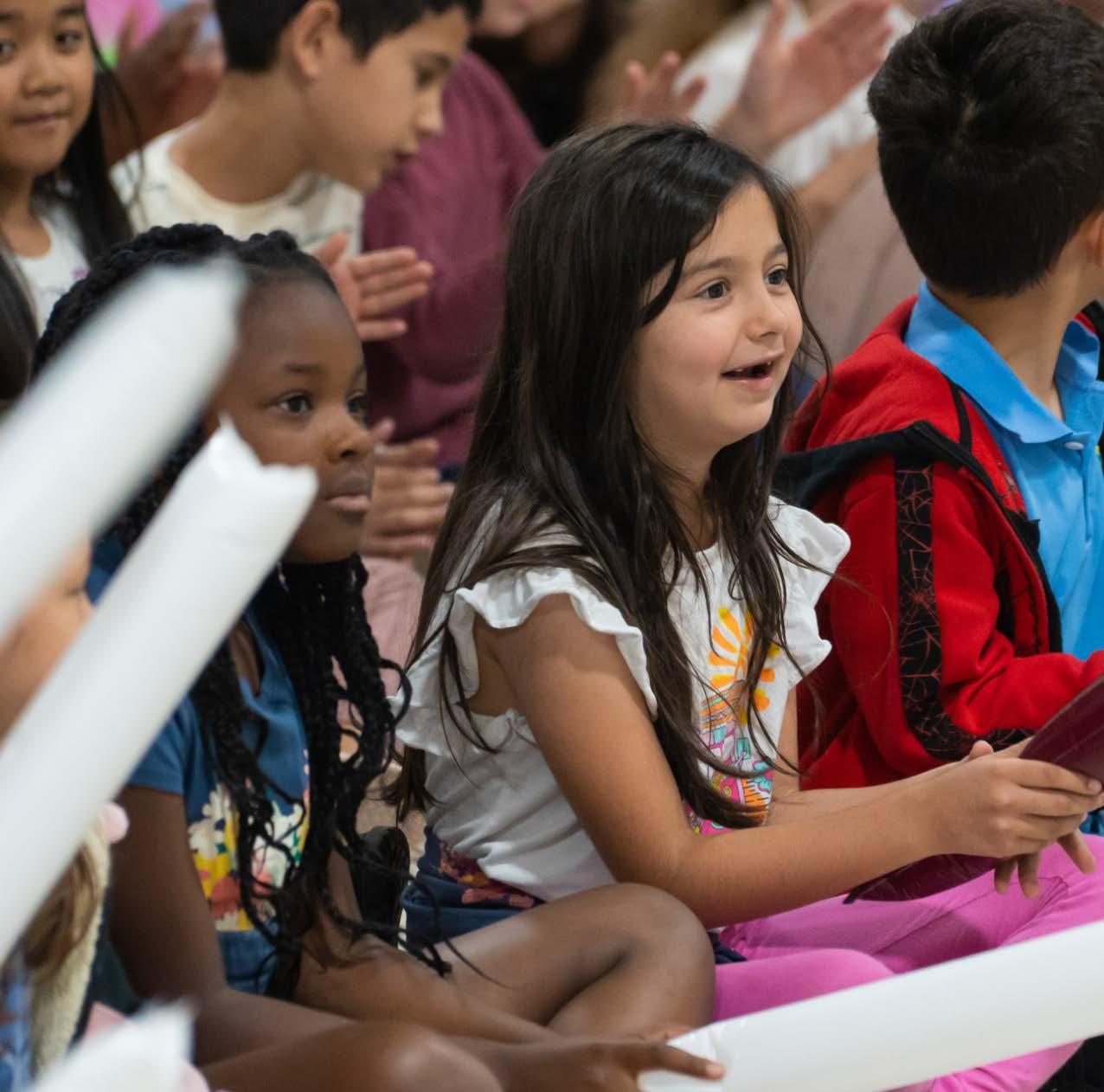
TABLE OF CONTENTS
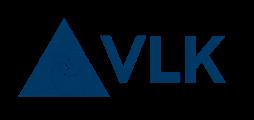
Introduction
Design Process
Site Plan/Floor Plans
Pedagogical Foundations
Classroom Wings
Media Center/Makerspace
Fine Arts
Design Lab
Athletics
Safety & Security
Brand Identity
INTRODUCTION
Welcome to Parker Elementary School in Sherman Independent School District, a school collaboratively designed to support actively engaged learners. Modern learning spaces offer students the ability to learn in a variety of areas. Moreover, flexible spaces allow teachers to design experiences that foster collaboration, innovation, and creativity, and hands-on active learning.


This User Manual will benefit the campus leadership and staff who will educate children in this elementary school environment. This manual includes a description of the design process, building design, and suggestions as to the use of the innovative spaces that have been purposefully designed into the building for instructional purposes.

DESIGN PROCESS



The design of Parker Elementary School emphasizes transformative learning by creating dynamic spaces that promote flexibility and adaptability, supporting a wide-range of teaching methods and student needs. These spaces are equipped with cutting-edge technology, ensuring that students have the tools they need to succeed in an ever-changing world. Collaboration areas are integrated, fostering teamwork, belonging, and active problem-solving.
The Media Center houses modern technology for student use, and is designed not only as a literacy resource, but for innovation and creativity. Grade levels experience collaboration areas allowing teachers to have the flexibility to move students to the most conducive area for lessons, as well as have variety when deciding on student group sizes. Art, music, and P.E. have purposefully designed dedicated spaces for these specialized instructional areas. Additionally, multiple playgrounds offer age-appropriate socialization areas, as well as play equipment.

SITE PLAN

FLOOR PLAN
ADMINISTRATION
ACADEMICS
SPED
MEDIA CENTER/ COLLABORATION
FINE ARTS
ATHLETICS/STORM
SHELTER
CAFETORIUM
SERVICE
2ND
1ST
MAIN ENTRY


KINDERGARTEN
LEVEL ONE

FLOOR PLAN
ADMINISTRATION
ACADEMICS
SPED
MAKERSPACE EXCHANGE/ COLLABORATION SERVICE

5TH
LEVEL TWO
4TH
3RD
PEDAGOGICAL FOUNDATIONS: GRADE LEVEL COMMUNITIES
The learning process is dependent on student engagement (Schlechty, 2002). When students experience a sense of belonging and support, they are more likely to engage authentically, make positive behavioral choices, and achieve deeper levels of learning (Osterman, 2000). Creating emotionally and physically safe environments is essential to fostering this growth. Grade-level communities enhance engagement, by promoting strong peer and teacher relationships, crosscurricular collaboration, consistent behavioral expectations, and timely academic and behavioral support (National Research Council, 2004). Purposefully designed with the learner in mind, collaboration spaces within each grade level provide flexible environments that promote peer interaction, inquiry-based learning, and choice. Collaboration spaces enhance learning by offering students opportunities to participate in hands-on, collaborative activities that support active knowledge construction (Piaget, 1952). Research shows that these environments not only improve focus, motivation, and productivity but also contribute to emotional well-being, positive socialization, and a sense of autonomy (Oliveras-Ortiz et al., 2021). When students learn in intentionally designed spaces that foster ownership, connection, and belonging, they experience higher levels of engagement and academic achievement (Oliveras-Ortiz, Bouillion, & Koprowski, 2023).
Schlechty, P.C. (2002). Working on the work: An action plan for teachers, principals and superintendents. San Francisco: JosseyBass.
Osterman, K. F. (2000). Students’ need for belonging in the school community. Review of Educational Research, 70(3), 323–367.
National Research Council. (2004). Engaging schools: Fostering high school students’ motivation to learn. Washington, DC: The National Academies Press.

Piaget, J. (1952). The origins of intelligence in children (M. Cook, Trans.). New York, NY: International Universities Press.
Oliveras-Ortiz, Y., Bouillion, D. E., & Asbury, L. (2021). Learning spaces matter: Student engagement in new learning environments. Journal of Education, 201(3), 174–182.
Oliveras, Y., Bouillion, D., & Koprowski, S. (2023). Social Emotional Learning Practices and Learning Spaces (p. 31). University of Texas at Tyler.
CLASSROOM WINGS
DESIGN FOR INCREASED STUDENT ENGAGEMENT
On the first floor, the Kindergarten section has its own dedicated wing, while the 1st and 2nd grades share a wing. Each grade features a central Exchange space to foster collaboration. Moving up to the second floor, you’ll find the 3rd through 5th grades, each housed in their designated pods. These pods play a crucial role in nurturing a strong sense of belonging and community within each grade level.

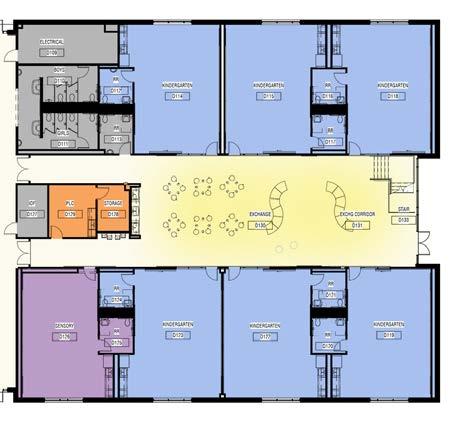

CLASSROOM WINGS
COLLABORATION SPACES - EXCHANGE
Exchange Spaces, located within each classroom wing, are the largest of the collaboration space types. These flexible and multipurpose areas are designed to support a variety of learning experiences, including presentations and large-group activities. They can also serve as an alternative to the traditional classroom setting, offering a dynamic environment for crosscurricular projects such as art or science explorations. With strong visual connections to surrounding classrooms, these spaces are easily accessible and can be effectively monitored through shared transparency. Outfitted with writable surfaces, integrated technology, and flexible furnishings, Exchange spaces support a wide-range of instructional approaches and studentcentered learning opportunities.

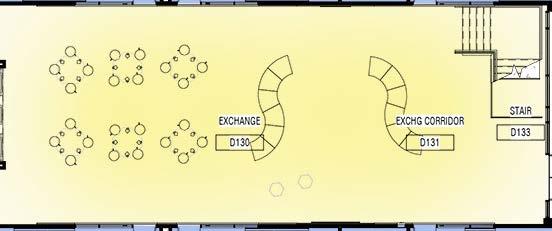

CLASSROOM WING
CLASSROOM WINGS

CREATE SPACES
The Create space redefines the traditional classroom by offering a more flexible learning environment. Create spaces may include both wet and dry project areas, adaptable furniture, various writing surfaces (including mobile options), advanced technology, and ample natural light. Within a classroom wing, Create spaces connect directly to an Exchange Space to extend the learning environment.

MEDIA CENTER & MAKERSPACE
MEDIA CENTER
The media center is located on the daily path for students to have easy access. It is a flexible, inviting space designed to encourage collaboration and exploration. Incorporating adaptable furniture, this technology rich space prepares students for a digital future.
MAKERSPACE
A makerspace functions as a dynamic, studentcentered fabrication lab that encourages active, hands-on learning and creativity. In this flexible environment, students engage in meaningful exploration, set and work toward individual learning goals, and develop problem-solving skills as they acquire and apply new knowledge. Teachers also have access to a variety of materials to model lessons and facilitate learning experiences, empowering students to innovate, take risks, and pursue long-term goals through real-world, collaborative projects.



MEDIA CENTER
FINE ARTS

The music room connects directly to the cafetorium stage. The dual-sided stage opens to the classroom on one side and the cafetorium on the other. This gives music students the opportunity to practice on the stage and also eliminates travel time for performances. When both partitions are closed, it can provide the campus an additional flex room. The art room is a large flexible space with ample natural light and direct access to the exterior art patio. It includes an art storage room for student projects and a kiln room with ventilation.

FINE ARTS

The cafetorium includes a stage for lectures and performances. The music room has a direct connection to the dual-sided stage.

Cafetorium
CAFETORIUM
DESIGN LAB
Located within each classroom wing, the Design Lab/PLC serves as a place for instructional teams, designed as a space to support effective teaching and continuous improvement. This dedicated space empowers educators to engage in lesson planning, instructional collaboration, student progress monitoring, data analysis, and the sharing of best practices. The environment fosters a growth mindset and ongoing professional learning, ensuring that teams are equipped to meet the ever evolving needs of their students.
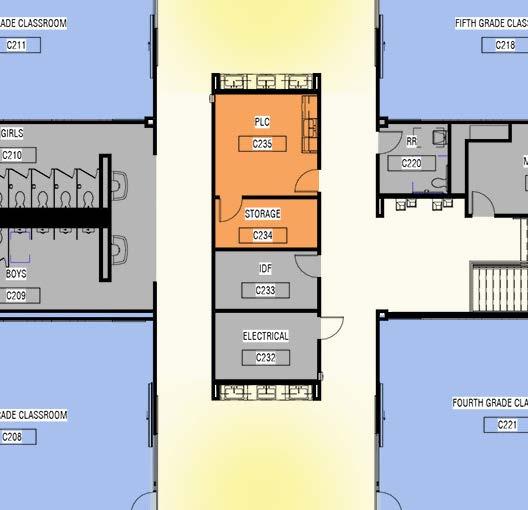


ATHLETICS

ATHLETICS
The athletics program is intentionally designed to promote pride, sportsmanship, and perseverance while supporting intellectual, physical, and emotional balance. It encourages students to take healthy risks in pursuit of long-term goals, fostering discipline and resilience. The gymnasium also serves as a storm shelter for the entire school.

SAFETY & SECURITY
SAFETY & SECURITY
VLK’s mission is to deliver tailored safety and security solutions that support and enhance the built environment. The team is committed to proactively identifying and managing risk through comprehensive planning, expert insight, and ongoing education. By empowering clients with knowledge and collaborating closely with local first responders, VLK helps create strategies that prioritize protection, resilience, and improved quality of life, ultimately contributing to a safer, stronger community.
During the design of this campus, safety and security were foundational priorities. Specific features include:
• Clear line of sight from the administration area to the parking lot
• Sliding marker boards over classroom windows to enhance safety while maintaining instructional flexibility
• Balanced use of natural light with integrated blinds to support visibility and well-being
• Intentional separation of public and private zones within the building
• A secure, controlled entry vestibule for visitors
• Strategic interior layouts to maintain line-of-sight and visibility across common areas
• Doors to allow lockdown of each academic wing
• Storm shelter
• Continuous 8’ fencing encloses the student play zones

BRAND IDENTITY



